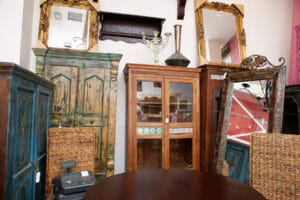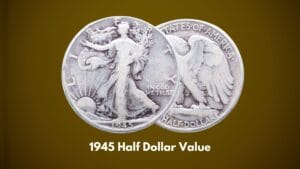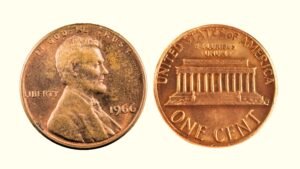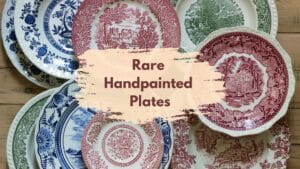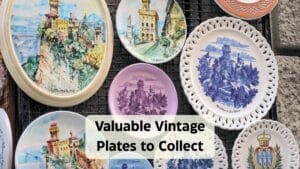Are you looking for a new home for the dearly antique items in the attic? If yes, then you’ve arrived at the right place! Selling an old item might look easy at first, but when you step into the market, there are a lot of nuances, from antique pricing and authentication to delivering it to buyers safely!
So today, I will take you into the depths of the antique marketplace, exploring modern digital alleys and traditional brick-and-mortar avenues to sell your antiques. You will also find expert tips to make the best deal every time!
Key Takeaways
- If you want to sell a few antique items and can do all the packing and shipping, you can sell antiques via online sources like Etsy, eBay, FBMP, and RubyLane.
- For some huge ticket antique items, antique auctions are a good place to start.
- If you simply want to sell old stuff from your house to make some space or money, yard or garage sales are the most efficient ways.
- For high-value vintage items, make sure to include all the authentication & provenance details and signatures.
Knowing the Value of Your Antiques Before Selling

Before you sell your dear antique item, it’s important to identify and appraise it rightly. While it’s best to get professional help online or offline, doing some homework will prove to be helpful and save you from scams!
- Look for the Aged Markings: Examine your item inside out to spot any maker’s mark, hallmarks, logos, serial or patent numbers, maker’s signature, manufacturing date, and location. These marks help verify the item’s age and rough value!
- Verify the Visible Features & Craftsmanship: Try to identify the materials used in the construction of your item, its workmanship, style, color, etc. Usually, antiques have finer details & expensive materials, while newer pieces are simpler.
- Examine the Item’s Condition: Look all over your antique piece to trace any chips, cracks, dents, broken pieces, etc., and note them down. Remember, the better the condition, the more valuable your old item is!
- Additional Research (Online or Offline): Compare your item with similar old items via antique forums, e-commercial sites, etc., and check their resale market prices. Also, visit antique shows, fairs, & stores and talk to experts and other sellers to know about the item’s value and desirability!
- Keep Records: Document all your research findings, communications, written features, appraisals., etc., as these authenticate your antique and may hike its value!
While selling an antique item, it’s preferable to get a formal written appraisal (a documented value of an antique based on its condition, age, & market condition) via an antique expert.
Expert Views on Selling Antiques Online
If you want to trade your old stuff without having to visit antique shops and fairs, sell your antiques ONLINE! Modern technology has given us many e-commerce sites where you can put your antique up for a bid, and buyers can contact you to buy it!
But here’s what you MUST know!
While you can practically sell everything online, avoid selling heavy antiques like furniture pieces, big trunks, safes, etc., online. There are two reasons for the same.
First, shipping such huge items will be as tiresome as costly. And I’m sure you won’t want to pay more shipping costs than your antique’s cost. And second, shipping big items to distant cities or countries may also damage them during transportation.
Nonetheless, online antique sites or e-commercial sites are great platforms for selling small to medium-sized collectibles like toys, glassware, china, bottles, vases, etc.
Now, let’s explore some most popular antique-selling sites:
1. eBay

eBay allows you to conduct a smooth business-to-consumer or consumer-to-consumer selling experience. And to sell your precious antique, you need to set up a user account, create good listings, and put your antique up for a bid.
But while selling antiques on eBay, try to figure out what buyers want to know! Here are my expert tips for the same that will boost your sales on eBay:
1. Write Catchy Titles & Descriptions in the Listing:
Always use relevant and popular keywords in the listing title to make the listing more with users’ queries. And while writing item descriptions, use words and, especially, abbreviations that a normal user would use or prefer.
Lastly, add all the details about your item that your buyers would want to know, and not only what you want to tell them.
If your antique item has an interesting story attached to it, feel free to share it in the description. It makes antique lovers curious about and connected to the item!
2. Adding Appropriate Categories & Tags:
Try to identify the common, effective keywords and categories via completed sales and auctions. Listing the item under the best relevant categories can help them appear in the searches. This will also help you understand what details common buyers prefer knowing in the listing.
3. Review Prices via eBay Sales & Completed Auctions:
Review completed sales of similar items and try to understand the reasons (condition, bidding, etc.) behind the price differences. This will help you finalize a decent price for your antique.
4. Selling the Right Items at the Right Time:
Try to identify antique trends by evaluating current sales. And don’t forget to promote relevant items before the holidays. Another important step is to avoid listing many unrelated items all at once. List similar or closely related items at once and wait a little before listing something entirely new.
5. Add Pictures that Show the Overall Item:
Upload high-quality photos of your antique item from different angles. And while you may think it’s important to let users know of the defects, if any, you should rather show them the full view so they can judge the quality and condition by themselves.
You can edit your pictures, like cleaning them and creating a white background behind the item using the official eBay app.
6. Signature Confirmation:
To avoid buyers’ scams and abuse, get signature confirmation! eBay also offers seller protection for listing old items priced over $750, provided the signature confirmation.
2. Etsy

If you ever dreamt of opening an antique shop or brand of your own, Etsy can make it happen. Yes, Etsy allows you to sell antiques via your own shop, but online!
Etsy is getting more and more popular as an e-commerce platform for antiques. And it shows its recent reports showing the YoY increase in searches:
59% YoY increase for “vintage brass items.”
89% YoY increase for “vintage gold mirrors.”
So, if you want to become a vintage-selling brand, start Etsy-ing now by setting up an Etsy account and establishing your shop. Use these expert tips to help your Etsy shop thrive!
1. An Interesting Shop Name:
Your Etsy buyers will recognize you with your shop’s name. So, make sure it’s catchy enough to their minds by incorporating your primary niche in the title. And avoid using amateur or irrelevant names as it can pose your shop as inauthentic!
2. Optimize Your Shop:
Do constant research on Etsy to find out what searches optimize your shop with listing on Etsy’s search engine. Identify your competition in the niche and try to spot the loopholes to one-up them. Try to keep your shop focused on one type of vintage item!
3. Use All the Available Tags in the Listing:
Etsy allows you to add 13 different tags to your listing. So don’t be shy and add all relevant 13 tags to optimize and help your listing top the searches. However, avoid adding repeated, misspelled, multilingual tags at all costs!
4. Provide Authentication Proof:
To build your image in buyers’ minds, always display authenticity in your listings. Add documentation, expert appraisal, or recommendations for your buyers to check. These proofs will also save your shop from getting flagged down!
5. Renew Your Listings:
If your items don’t sell within four months of listing, you’ll need to pay some amount to keep them listed. But don’t step back from this investment, as it can boost your listing, especially when the keyword you optimized your item for is more competitive than usual!
3. Facebook Marketplace

It’s not just eBay or Etsy; even Facebook allows you to sell antiques! You can simply enter the marketplace via the website or application and list your items with decent pictures and descriptions to sell!
If you’re new to FBMP, keep these points in mind:
- Create a huge buyer base by selling unique items as well as antique and vintage stuff.
- If your item doesn’t sell for some time, renew the listing and reduce the price by a few dollars. You can also use new tags to reach new people.
- Always stay in contact with multiple potential buyers for a single item in case your main buyer doesn’t show up. Tell them that the sale is pending instead of just ‘sold!’
- Promote your listing in relevant antique-related groups or online garage sales to boost the sale.
4. Other Online Sources
These are a few other online platforms where you can sell vintage collectibles, such as:
- Ruby Lane
- Craigslist
- Bonanza
- Specialized antique forums
Offline Venues to Sell Your Antiques
If you want to sell your timeless antique the old way, you can check out these offline venues! Unlike online sales, most of the offline ways, like antique stores, auctions, fairs, & sales, save you from tough tasks like packing and shipping!
Moreover, via offline sales, you don’t have to worry about the size of your antique. From a full-fledged two-seater sofa to a huge vintage safe, you can sell anything offline! But where? Let’s find out!
5. Local Antique Stores

The first venue you must explore to sell an antique is any antique store in your area. But before you directly take your old stuff there to sell, take a visit first.
Here are some more expert tips to keep in mind!
- Try to understand what the store is about, what kind of old items the dealer is interested in, and their buying policies.
- Research your vintage items to come up with an estimated value before your first meeting. The dealer may not tell you everything about your piece for free.
- While antique store sales look hassle-free, you may not make more than 50-60% of your item’s appraised value. So, it’s best to come up with a price point, generally around 75% of the item’s estimated retail price.
- Approach a reputable, knowledgeable antique store or dealer who can make a fair deal with an accurate price for your item.
6. Antique Shows/Fairs

Local antique shows or fairs are another great means to sell your old items. Once your application is finalized by the show’s organizer, you can set up your stuff for sale!
But remember these few expert secrets before approaching an antique show:
- Check out the show personally before setting up for it to make sure it’s not an off-place for your antiques. Your items must not look out of place in the show!
- Curate your booth carefully and creatively to compliment your antique stock. You may need to rent stuff like tables, showcases, etc., or you can bring your own stuff to set up your booth.
- Setting up for shows, especially in distant areas, can be quite expensive. So, make sure you have enough trendy antique stock to sell and make more money than you spend.
- Stock your inventory with low and high-priced antiques, so everyone can buy your stuff.
- Always read the antique show contract & do’s and don’ts before finalizing your booth!
7. Auction Houses

The second place you can explore is antique auction houses. These houses will not only sell your item but also help with everything from initial valuation to bidding to delivery!
But where to find such auctions?
You may come across two types of antique auctions: local, doing small, estate-based sale auctions, and renowned, doing high-end bidding or ticket items.
Bonhams, Fontaine’s Auction Gallery, Christie’s, and Sotheby’s are some of the most acclaimed auction houses you must contact.
But if live auctions are not your cup of tea, you can also sell at online auction houses, like Christie’s, Live Auctioneers, and Heritage Auctions. Besides these, eBay also allows you to sell your antiques via auction!
Here are some tips to make the best auction house deal!
- Gather and carry all the proofs, like sale receipts, auction records, appraisals, original pamphlets, etc. These documents will prove the provenance and authentication of your item and make it more valuable.
- Make sure to discuss the reserve (the minimum cost your item may sell for) with the auction house.
- Don’t forget to read about the auction house’s guarantee conditions for an antique item.
Selling at huge auctions is quite time-taking till you receive your final payment. So, if you want a fast process, approach a small-scale auction house.
8. Consignment Shops

Consignment shops work on commission. You can showcase your antiques in the consignment shop, jointly assign a price, and split the sale’s money with the dealer or shop owner once it’s sold.
Keep in mind these points while selling antiques via consignment shops:
- Know the consignment rules in and out before making the deal.
- If possible, take some guarantee from the shop owner about your item’s safety when it’s in the shop.
- Consider the antiques’ authentication documents to ensure the dealers don’t underprice your antique.
- Make it clear that you’re not obliged to pay any amount to the shop if your antiques are not sold.
9. Other Offline Venues
Apart from the above venues, here are a few other options to try to sell antiques!
- Flea Markets: A seasonal market where you can rent a space to showcase and sell your antiques.
- Garage or Yard Sales: Personal sales in your garage or yard to sell your old, antique stuff directly to the buyers.
- Estate Sales: Personal sales to sell all the items on an estate directly to buyers.
- Pawn Shops: To sell old stuff temporarily to borrow money (or permanently).
Final Words
Whether you want to make some money, do some serious business, or simply get rid of your antique items, there are many ways to do it! If you can do all the packing & shipping stuff, you can directly sell to buyers. Otherwise, approach antique shows, stores, and auctions!
Note: This article is intended for informational, educational, and entertainment purposes only. Some images are illustrative and may not represent actual brands, products, or related entities. All trademarks, product names, brand logos, packaging, and other intellectual property referenced remain the exclusive property of their respective owners. Any brand mentions or references are provided solely for descriptive and educational context and do not imply any formal or commercial association.

